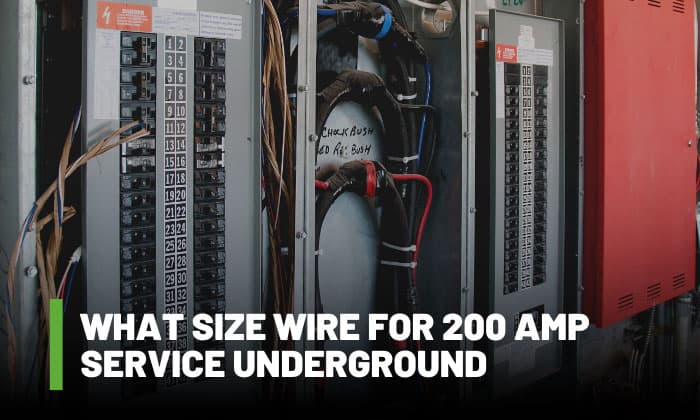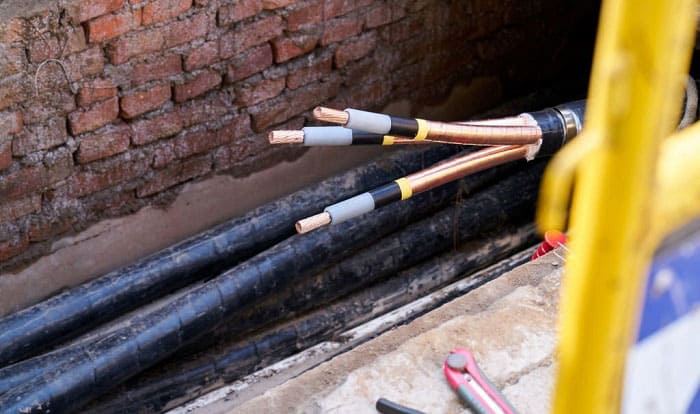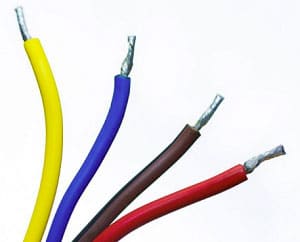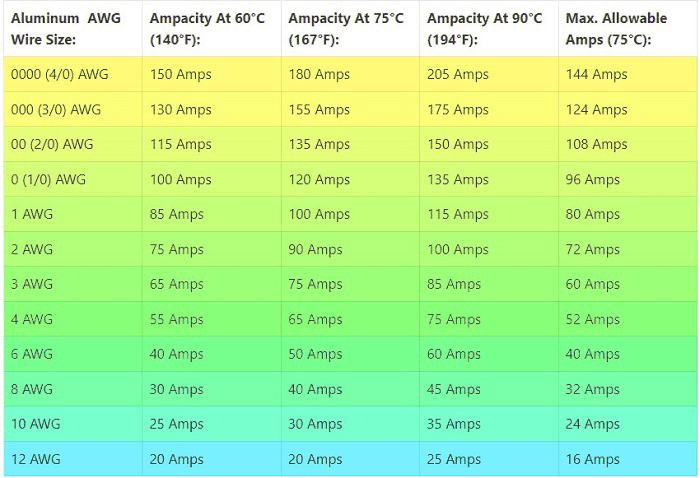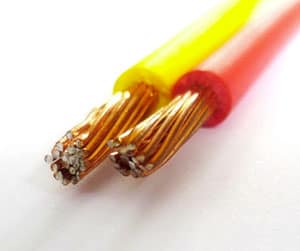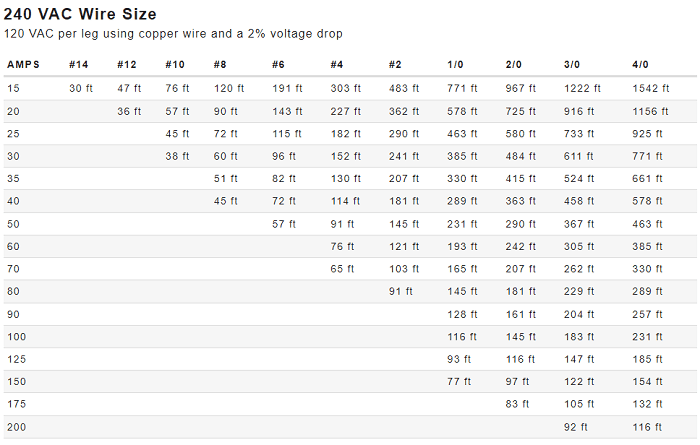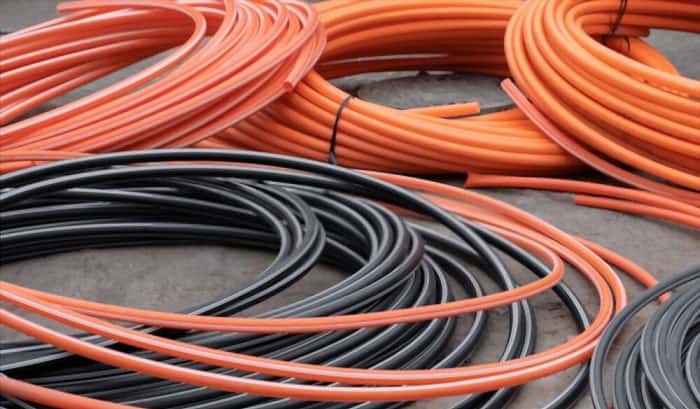Running a 200-amp wire from a service panel through a conduit that’s below the ground can be a tricky challenge. One of the criteria you need to fulfill is figuring out what size wire for 200 amp service underground.
The correct size wire for a 200-amp underground service depends on variables like the distance from meter to panel. Use a higher gauge wire as the space between these two objects becomes larger.
Aside from the distance between the service panel and the conduit, you also need to think about other factors for the circuit to work properly. So keep reading to learn about these other elements to help you choose the correct size wire to use.
Table of Contents
What is the Correct Wire Size for 200 Amp Service Underground?
As mentioned previously, the appropriate gauge wire to use for a 200-amp underground service often depends on multiple factors. Aside from the distance, you should also consider the amperage and voltage of the electrical service.
Generally, a 2/0 copper wire is ideal for a 200-amp service that’s below the ground. On the other hand, a 3/0 copper wire can be a better option than a 2/0 variant to provide adequate surge protection, particularly during thunder and lightning storms.
You may also use a 4/0 aluminum conductor to save costs. It should provide adequate current without being heavy.
Voltage is another factor that plays a role in choosing the correct cable size. This element generally coincides with the distance needed for the circuit.
Here are some examples based on certain voltage and circuit distance requirements:
120-volt Circuits
- 50 feet: 14 gauge wire
- 64 feet: 10 gauge wire
- 94 feet: 6 gauge wire
240-volt Circuits
- 100 feet: 14 gauge wire
- 128 feet: 10 gauge wire
- 188 feet: 6 gauge wire
Types of Wire
Oftentimes, you would need two wires for underground electrical service. These wires can either be aluminum or copper-clad aluminum. Take note of the benefits and drawbacks of using either option to ensure the circuit runs smoothly and safely.
1. Aluminum Wire
Although aluminum isn’t as sturdy as copper, it’s a relatively inexpensive option. It’s also lighter than its copper sibling, making it ideal for budget-conscious property owners.
However, this lightweight and fairly less conductive construction also means sizing differs when choosing the correct aluminum wire size. Here’s a chart of some examples of aluminum wires and their sizes based on their ampacities:
2. Copper-Clad Aluminum Wire
A copper-clad aluminum wire is more durable than its standard counterpart. It’s still reasonably inexpensive when compared to copper wire. It’s because this type of wire only uses a thin sheet of copper for its cladding, unlike the typical copper wire.
Also, copper-clad aluminum is still reasonably lighter than copper. However, it’s still likely to break, split, or encounter other issues because of its lower tensile strength.
Nonetheless, a copper-clad aluminum wire typically uses the same sizing reference as an aluminum variant.
For example, a 4/0 aluminum wire will have the same ampacity at 140 degrees Fahrenheit (60 degrees Celsius) as a 4/0 copper-clad aluminum variant. You can see the same concept when looking at other size wires, such as a 1/0 wire for both materials.
The Length Your Service Wire Runs Matters
Although both aluminum and copper wires have a general rating of 200 amps, the latter option is typically usable for longer distances. It’s because you need a smaller copper wire than an aluminum one to carry the same amount of current.
Also, the voltage drop can become larger as the length of the wire used becomes longer. As a general rule of thumb, aim for a wire length that won’t result in a drop above 3%.
The NEC 310-16 rule dictates that the total amps for a 200-amp wire increases 20% per 100 feet of distance. For instance, a 200 amp service 200 feet connection has about 40% more total amperage needs than a standard electrical connection at close range.
And because wires should only hold 80% of their rated amperage, you need to use a higher size than recommended to ensure safe electrical delivery.
In this case, a 200 feet, 200 amp sub panel wire size may need to be rated for 350 amps to ensure a stable current. If we increase the distance up to 300 ft, you would need to account for a 70% amperage boost on top of the 80% rule.
Take a look at the following chart that shows the recommended wire size based on the amps and distance of the service:
How to Calculate Wire Size?
Calculating the correct wire size, particularly for a 200 amp residential service, typically involves the following formula:
200 amp x 100% / 80% = 250 amps (to account for the 80% rule)
Next, determine how long your wire run is. Add 20% for 100 feet and 10% for 50 feet. So, if your run is 150 feet, you’ll need to increase the amperage of the wire by 30%. Hence:
250 amps x 1.3 = 325 amps.
The conduit size should be able to carry 325 amps. Ensure that the wire’s conduit is reasonably large for the material to pass through without causing breaks or tears.
FAQs
Check Local Electrical Codes & Permit Requirements
Electrical wiring installers should follow certain codes. One code, in particular, is the NEC 300.5 Underground Wiring guideline.
This code states different rules for electricians to follow, such as:
- A warning ribbon should exist in the trench, and it should be 12 inches from the subterranean installation.
- The conduit should be in a suitable position wherein it won’t harm the cable or wire when the assembly encounters movement.
- The conduit should have a metal construction or a sturdy non-metallic material.
As for the permits needed to install an underground service, these documentations often differ for each region. Ask your local government about these permits to ensure you’re getting the correct certifications for the installation job.
What Are 200 Amp Electrical Service Installation Costs?
Installation costs for a 200-amp service generally range from $2,000 to $3,500. The overhead may increase depending on the difficulty of the job and the additional tasks to complete.
Property owners should still prepare to spend about $8 per square foot for the electrical wiring installation. Again, the price per foot may vary depending on certain factors, such as the contractor or technician’s expertise and the property’s location.
How Many Amps Can I Put On A 200 Amp Panel?
A 200-amp service panel shouldn’t cater to more than 160 amps. Otherwise, the circuits connected to the panel can be at risk of overloads. Identifying the load of each breaker in the panel is essential to ensure this electrical problem won’t occur.
What Size Ground For 200 Amp Service?
A 200-amp service should use a 000 (3/0) ground copper wire. Pair this wire with a 4-gauge copper conductor so that the electricity will not put people nearby in immediate danger.
Bear in mind that the ground wire and neutral wire have different functions. The latter supplies the current’s return path while the former supplies the electrical protection.
What Size Wire Do I Need For A 200 Amp Service-Entrance?
The entrance cable for 200 amp service should have a 255-amp ampacity. You can use a 250 kcmil wire, but it’s often an ideal choice to exceed the base amount for enhanced protection.
How Many Amps Can You Have For 100 Amp Service?
The maximum load for a 100-amp service is 90 amps. The panel should have a 10% margin to ensure the panel board’s safety.
Furthermore, you can refer to this article to know the best wire size for a 60 amp sub panel.
Conclusion
Now that you reached the end of this post, you should have an idea of what size wire for 200 amp service underground to use. Remember, the size of the wire to use in a circuit depends on factors like the distance between the main breaker and the service panel.
Generally, a 2/0 copper wire should suffice. However, installers should also think about using a 3/0 variant to enhance the protection and stability provided by the electrical connection.

I am Edwin Jones, in charge of designing content for Galvinpower. I aspire to use my experiences in marketing to create reliable and necessary information to help our readers. It has been fun to work with Andrew and apply his incredible knowledge to our content.

